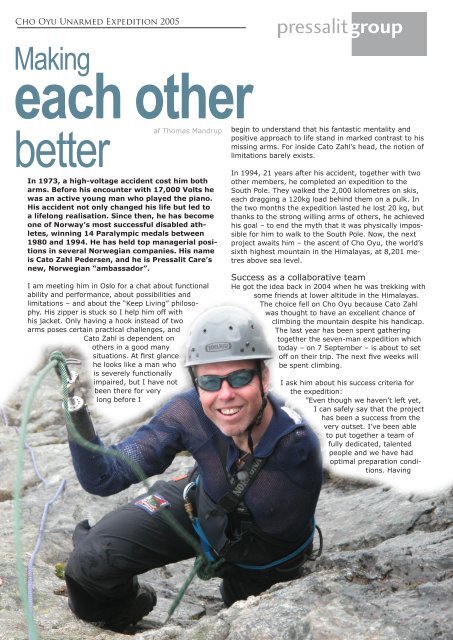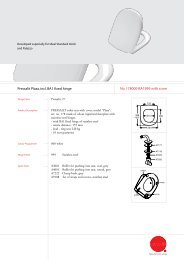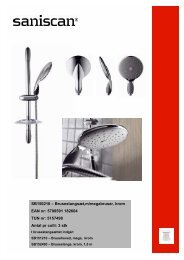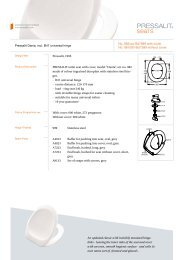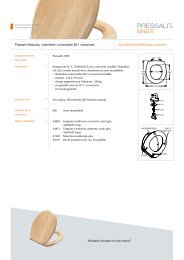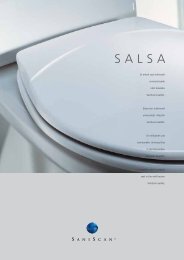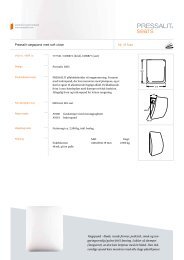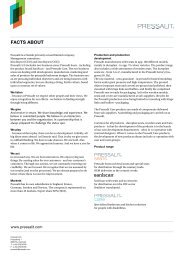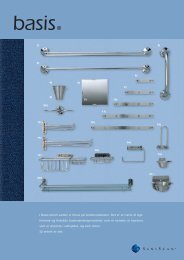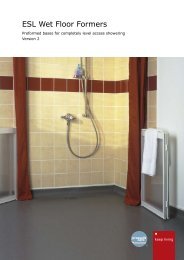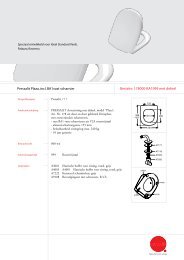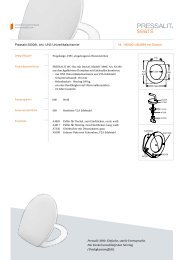better - Pressalit A/S
better - Pressalit A/S
better - Pressalit A/S
Create successful ePaper yourself
Turn your PDF publications into a flip-book with our unique Google optimized e-Paper software.
Cho Oyu Unarmed Expedition 2005<br />
Making<br />
each other<br />
<strong>better</strong><br />
af Thomas Mandrup<br />
In 1973, a high-voltage accident cost him both<br />
arms. Before his encounter with 17,000 Volts he<br />
was an active young man who played the piano.<br />
His accident not only changed his life but led to<br />
a lifelong realisation. Since then, he has become<br />
one of Norway’s most successful disabled athletes,<br />
winning 14 Paralympic medals between<br />
1980 and 1994. He has held top managerial positions<br />
in several Norwegian companies. His name<br />
is Cato Zahl Pedersen, and he is <strong>Pressalit</strong> Care’s<br />
new, Norwegian “ambassador”.<br />
I am meeting him in Oslo for a chat about functional<br />
ability and performance, about possibilities and<br />
limitations – and about the “Keep Living” philosophy.<br />
His zipper is stuck so I help him off with<br />
his jacket. Only having a hook instead of two<br />
arms poses certain practical challenges, and<br />
Cato Zahl is dependent on<br />
others in a good many<br />
situations. At first glance<br />
he looks like a man who<br />
is severely functionally<br />
impaired, but I have not<br />
been there for very<br />
long before I<br />
begin to understand that his fantastic mentality and<br />
positive approach to life stand in marked contrast to his<br />
missing arms. For inside Cato Zahl’s head, the notion of<br />
limitations barely exists.<br />
In 1994, 21 years after his accident, together with two<br />
other members, he completed an expedition to the<br />
South Pole. They walked the 2,000 kilometres on skis,<br />
each dragging a 120kg load behind them on a pulk. In<br />
the two months the expedition lasted he lost 20 kg, but<br />
thanks to the strong willing arms of others, he achieved<br />
his goal – to end the myth that it was physically impossible<br />
for him to walk to the South Pole. Now, the next<br />
project awaits him – the ascent of Cho Oyu, the world’s<br />
sixth highest mountain in the Himalayas, at 8,201 metres<br />
above sea level.<br />
Success as a collaborative team<br />
He got the idea back in 2004 when he was trekking with<br />
some friends at lower altitude in the Himalayas.<br />
The choice fell on Cho Oyu because Cato Zahl<br />
was thought to have an excellent chance of<br />
climbing the mountain despite his handicap.<br />
The last year has been spent gathering<br />
together the seven-man expedition which<br />
today – on 7 September – is about to set<br />
off on their trip. The next five weeks will<br />
be spent climbing.<br />
I ask him about his success criteria for<br />
the expedition:<br />
”Even though we haven’t left yet,<br />
I can safely say that the project<br />
has been a success from the<br />
very outset. I’ve been able<br />
to put together a team of<br />
fully dedicated, talented<br />
people and we have had<br />
optimal preparation conditions.<br />
Having
said this, I also have certain “value goals” of my own<br />
for the trip: primary among them being to maintain<br />
friendship within the group. To remain open and playful<br />
despite the challenges that lie ahead. And that we are<br />
sufficiently aware of what we are doing to know why<br />
our summit attempt succeeds – or fails.<br />
Obviously, I’m very dependent on other people’s help<br />
– both at home and on the expedition. I don’t make any<br />
bones about that, which is why it’s all about learning to<br />
work well as a team. It requires that each of us does<br />
our utmost to perform at our very best, but it’s also<br />
about making each other perform <strong>better</strong>. That’s why the<br />
project has been given the working title ’making each<br />
other <strong>better</strong>’. Once we’re above 6,500 metres, we’re really<br />
all functionally impaired. The oxygen content is only<br />
roughly a quarter of what it is at sea level. It’s difficult<br />
to explain what this means to people who have<br />
never experienced it, but even a simple<br />
task like pulling on your boots<br />
requires a Herculean<br />
effort. You’re constantly gasping for air. Regardless of<br />
how well prepared each of us is, no one can predict<br />
how their body will react at high altitude. We’re going<br />
to experience ups and downs, which is why we can only<br />
complete the expedition if we function as a team, with<br />
everyone taking turns to help each other.”<br />
The expedition numbers several of Cato Zahl’s personal<br />
friends and he is excited in more ways than one about<br />
testing these friendships “at high altitude”. Remaining<br />
friends is not to something he takes for granted when<br />
being pushed under such extreme conditions, but he<br />
rates friendship higher than reaching the summit of Cho<br />
Oyu: ”If we reach the summit but part on bad terms,<br />
then the expedition will have been a failure for me,” he<br />
stresses. ”Whereas I can view the expedition as successful<br />
even if we don’t reach the top as long as I know<br />
that we all did our best and that<br />
we basically managed to keep<br />
the team together.”<br />
Getting used to<br />
high altitude<br />
is
achieved by means of a ”yo-yo procedure”, whereby expedition<br />
members climb a short distance up the mountain,<br />
gradually acclimatise to the lower oxygen content<br />
– and then climb back down a little. The next day the<br />
person climbs a little higher before repeating the whole<br />
procedure. And so it continues – until – they hopefully<br />
reach the summit. In their battle against the lack of<br />
oxygen, a strong mental attitude plays a vital role, and<br />
with his wealth of experience from elite sport, Cato Zahl<br />
truly has something valuable to offer the other expedition<br />
members.<br />
To be a “storyteller” – a teller of stories – from the<br />
summit is another personal goal. Reaching the summit<br />
will in itself be a story about our inability to judge a<br />
book by its cover, or functional ability and performance<br />
simply by looking at a person, and that other people<br />
who are slightly different from the norm possess a<br />
greater potential than we often expect. This is a message<br />
that Cato Zahl would very much like to hammer<br />
home to the welfare society, the labour market and to<br />
individuals in general. Personally, he views Cho Oyu as<br />
a learning opportunity - for the expedition will reveal<br />
the boundary of his own limitations.<br />
Functional ability and limitations<br />
Do you never stop to think about the risks involved in<br />
such an expedition?<br />
”People have told me that the expedition is a foolhardy<br />
undertaking. That it’s too dangerous for me. They said<br />
the same thing about our expedition to the South Pole.<br />
But in reality, there is no danger in what we’re doing.<br />
Crossing a busy road at the wrong place – can prove<br />
deadly, but our expedition is not inherently dangerous<br />
because we are constantly aware of safety issues. We<br />
spend the necessary time to ensure extra safety for<br />
me. Outside factors such as the weather, sickness and<br />
accidents can pose a threat but we can greatly reduce<br />
the risk through proper planning. The expedition team<br />
comprises top professional, well-prepared members<br />
and in Nepal we have allied ourselves with one of the<br />
world’s top sherpas, Dawa Chiri Sherpa, who will act as<br />
a guide and help assemble a local team to aid in carrying<br />
the equipment. So we have done what we can to<br />
give ourselves optimal climbing conditions.”<br />
How can you approach such a difficult task without<br />
focusing on limitations?<br />
”Your question goes to the very heart of the whole issue<br />
of functional ability and performance. Many people<br />
have a tendency to become bogged down by limitations<br />
and to view them as an insurmountable problem, which<br />
triggers a general feeling of despair in relation to task<br />
solving. We’re quick to call something difficult. I have<br />
had to realise that the more accurately I can describe<br />
a limitation, the easier it is to overcome it. It’s about<br />
“giving a name to the problem” – about dismantling the<br />
obstacle and breaking it down into its concrete subelements<br />
so we can see what is needed to solve each<br />
separate element. For example, there is nothing difficult<br />
about walking to the South Pole – all you have to do<br />
is find your direction and start walking. Physically it is<br />
exhausting, but that’s something entirely different. But<br />
it’s not – difficult.”<br />
While I am chewing this over, Cato Zahl continues:<br />
”Sometimes you fight a lack of motivation because<br />
you’re cold, tired or disheartened. Then the only option<br />
is to step back and try to assess the situation: - What<br />
exactly is the problem? Maybe you’re freezing to the<br />
bone. - Okay, what can I do about that? Have I got an<br />
extra pair of trousers in my rucksack? - Okay, would it<br />
be a good idea to put them on? In this way, you gradually<br />
break down a general limitation into specific things<br />
that are limiting your ability to function.”<br />
Keep Living<br />
As a physically impaired person, Cato Zahl is used to<br />
relying on auxiliary aids to compensate for his physical<br />
limitations. The prosthesis attached to his right arm<br />
is literally vital when he has to suspend himself from<br />
a climbing rope on the mountain face. Perhaps it is<br />
this ability to find concrete solutions to problems that
is reflected in his mentality, which virtually rules out<br />
limitations. ”Limitations are only inside our heads – as<br />
are possibilities,” is the title of a popular talk that Cato<br />
gives to Norwegian businessmen.<br />
”Generally speaking, the complexity of most company<br />
projects far exceeds that of an expedition like ours,”<br />
Cato points out. ”When I supervised the building of the<br />
Cato Centre (a rehabilitation centre in Norway of which<br />
Cato Zahl Pedersen was the initiator), the task was far<br />
more complex than the one facing us on the mountain.<br />
Getting all the finances in place, dealing with all the<br />
politic challenges and finding the right staff – now that<br />
was difficult.”<br />
“Breaking down” limitations has become a guiding light<br />
in his life, which is why he also has a positive attitude<br />
towards <strong>Pressalit</strong> Care’s ”Keep Living” philosophy and<br />
mission ”to provide maximum compensation for physical<br />
limitations”, which later becomes the subject of<br />
conversation.<br />
“When healthy people see a functionally impaired person,<br />
they often see a general limitation – a bit like the<br />
demotivated expedition member,” explains Cato Zahl.<br />
An employer avoids a person in a wheelchair because<br />
he perceives the person as a problem. In his civilian job<br />
as project manager, he works hard to knock down the<br />
doors of Norwegian companies – and at the very least<br />
get them to invite a person with impaired functionality<br />
for a job interview the next time they have a vacant<br />
position. Maybe they will discover that the best engineer<br />
is a wheelchair user and that his functional limitation<br />
can be alleviated using a stair ramp or a few simple<br />
auxiliary aids in a handicap toilet.<br />
FACTS:<br />
<strong>Pressalit</strong> Group has entered into a sponsorship<br />
agreement with Cato Zahl Pedersen and Cho Oyo<br />
Unarmed Expedition 2005. The agreement means<br />
that until the end of 2006, Cato Zahl will function<br />
as ambassador for <strong>Pressalit</strong> Care’s products in<br />
Norway.<br />
The Cho Oyo Expedition will begin on 7 September<br />
2005 and is expected to take 5 weeks.<br />
It comprises seven members – six Norwegians and<br />
one Dane. The youngest member is 26 and the<br />
oldest 53.<br />
In preparation for the expedition, Cato Zahl Pedersen<br />
has climbed Norway’s “Glittertind” mountain.<br />
<strong>Pressalit</strong> Care manufactures kitchen and bathroom<br />
solutions for the functionally impaired.<br />
Read more on:<br />
www.catozahl.no<br />
www.pressalitcare.dk<br />
www.pressalitgroup.dk<br />
Attitude to change<br />
In a strange way, time has drawn a dotted line through<br />
the high points of Cato Zahl Pedersen’s life. He thinks a<br />
lot about the “triangle” - beginning with his 17,000 Volt<br />
accident to his expedition to the South Pole and now<br />
Cho Oyu. His story is soon to become the subject of a<br />
book, he explains. Nowadays, Cato Zahl states without<br />
any hesitation that we learn most from adverse situations,<br />
and that attitude to change is the greatest challenge<br />
we should address. Strong words indeed from a<br />
walking torso.<br />
Before we round off our talk, I have to ask him if there<br />
is nothing at all that can phase a man such as Cato<br />
Zahl. Yes, he assures me. When the people he works<br />
with become indifferent, tepid and uninvolved or if team<br />
members fight one another – that can dishearten him<br />
and lead to a lack of commitment. If he is involved in<br />
a project in which he does not feel committed, then he<br />
has to find a proper way of moving on before it drains<br />
all his energy. Otherwise he chooses to maintain a positive<br />
outlook on life.<br />
The next time I feel I’m about to “give up” on one of<br />
my 10 kilometre runs or see more limitations in front of<br />
me than possibilities, I will think back to this meeting<br />
in Oslo and send a friendly thought to the man without<br />
arms, who is about to tackle his 8,201-metre-high<br />
mountain.<br />
<strong>Pressalit</strong> Care products provide maximum compensation<br />
for physical limitations. I have just met a man who<br />
has the recipe for providing maximum compensation for<br />
mental limitations – if he has any at all. Next to him, I<br />
have to admit to feeling a bit functionally impaired.<br />
keep living


